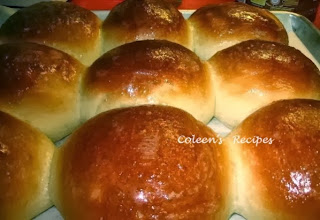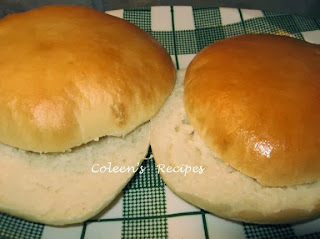Come On Be Brave
You CAN Succeed at Bread Making !!
I've been making this bread recipe for nearly 40 years and it has never failed me. It is a basic white bread that goes together in minutes (I make this recipe about once a week). It is nearly fool proof and a great recipe for beginning bread makers.
OR
5 cups Better for Bread Flour (see note below about flour)
3 tablespoons granulated sugar
1 tablespoon table salt
2 envelopes of active dry yeast
3 tablespoons vegetable oil
2½ cups very warm water
In the bowl of a stand mixer, place 2 cups of all purpose flour, 2 packets of dry active yeast (I use 2 level tablespoons because I buy it in a larger jar), 3 tablespoons of granulated sugar, 1 tablespoon of table salt and 3 tablespoons of vegetable oil (I use canola oil). Stir together
 NOTE: Normally, most yeast recipes tell you to dissolve the active dry yeast in water that is 110 degrees before you add it to the flour. However, 99.9% of the time I do not do it that way. If you mix the DRY yeast into the DRY flour, you can add hotter water because the flour will cool down the water before it can damage the yeast. That may sound complicated, but it isn't. The advantage of adding warmer water, is that it will jump start your yeast and your bread dough will raise faster using this method.If you are nervous about doing it this way, it might be a good ideato use an instant read thermometer with your first few batches of bread (just to reassure yourself). However, it isn't rocket science and after you make bread a couple of times, you will quickly learn what the water is supposed to feel like by holding hour hand under the running tap water.When I mix the DRY yeast into the Dry flour, I used 120° water
NOTE: Normally, most yeast recipes tell you to dissolve the active dry yeast in water that is 110 degrees before you add it to the flour. However, 99.9% of the time I do not do it that way. If you mix the DRY yeast into the DRY flour, you can add hotter water because the flour will cool down the water before it can damage the yeast. That may sound complicated, but it isn't. The advantage of adding warmer water, is that it will jump start your yeast and your bread dough will raise faster using this method.If you are nervous about doing it this way, it might be a good ideato use an instant read thermometer with your first few batches of bread (just to reassure yourself). However, it isn't rocket science and after you make bread a couple of times, you will quickly learn what the water is supposed to feel like by holding hour hand under the running tap water.When I mix the DRY yeast into the Dry flour, I used 120° water
 Stir 2½ cups of 120 degree water into the flour mixture and stir vigorously with a wooden spoon while you pour. Let this mixture sit for about 10 minutes; this will give the yeast time to activate.Start adding the rest of the flour, half cup at a time, mixing with a sturdy spoon in between each addition. When the dough gets too stiff to mix with a spoon, attach a dough hook to your stand mixer and turn on low.
Stir 2½ cups of 120 degree water into the flour mixture and stir vigorously with a wooden spoon while you pour. Let this mixture sit for about 10 minutes; this will give the yeast time to activate.Start adding the rest of the flour, half cup at a time, mixing with a sturdy spoon in between each addition. When the dough gets too stiff to mix with a spoon, attach a dough hook to your stand mixer and turn on low.
NOW HERE IS AN IMPORTANT TIP
When making dough, at this stage, something called "dough shag" is (can be) your enemy. If you add too much flour, too fast, you will get "dough shag" or dry shaggy pieces of dough. Click on this next photo so you can see the dry white sections/layers next to the wet sections of dough? I call it "shag"
Click on the photo to see the shag more clearly Shag is not totally a bad thing, it is just a clue that it is NOT time to add more flour. NEVER ADD MORE FLOUR IF YOU CAN SEE SHAG.
Here is another photo, see the shag?
I intentionally added the flour a little too quickly (in this next photo) so you could see what I mean by "shag".
Don't panic if you see shag, just keep "kneading" with your dough hook (or by hand) and the shag will eventually incorporate into the wet dough. Don't add more flour until it looks more like this:
Eventually, you will get all 5 cups of flour into the dough. When that happens, let your machine knead the dough (gently, on a low setting) for about 6-8 minutes (or by hand for 6-8 minutes). Stop you mixer every once in a while and pull all the dough off of the dough hook, scrape down the walls of your bowl and turn the ball of dough completely over and start the mixer again. You will have to do this a few times until the shag totally disappears and the dough clings together in a nice semi-solid "glob".
At the end of 6 to 8 minutes (exact time is not crucial), the dough should have worked itself into a smooth ball that stays on the dough hook when you raise the hook out of the bowl. The interior sides of the bowl should be fairly clean. It should look like this:
See how the dough ball has "cleaned" all of the little bits off of the bottom and sides of the bowl? This is what you want to see. The dough will not be sticky and it will feel like play doh when you touch it. If the dough is too soft, it will pull itself off of the dough hook. If that happens, add another quarter cup of flour and knead it a little longer.
Remove your dough from the dough hook, form it into a ball and place it in a greased bowl (I use a little vegetable spray). Spray the top of the dough with a little more, and cover it with plastic:
Place this covered bowl of dough in a nice warm place in your kitchen. Room temperature is OK, but if you have a warmer place (less than 100 degrees) place it there. After an hour, your dough will have risen substantially, (hopefully doubled in size).
Your dough should look
like this after an hour
(doubled in size)
When the dough has fully risen, turn it out onto your counter (some people say flour the counter at this stage, but I NEVER do) and push all of the air out of the dough. Cover it with an inverted empty bowl and let it sit for 15 minutes to relax (this will make your dough much easier to work with when you try to form it).
Depending on how you want to shape your dough, follow these general directions, but use your imagination.
Depending on the size of your loaf pan, you will get 2 or 3 loaves.
Cut your dough into 2 or 3 pieces and roll each piece into a large rectangle. Roll the dough into a log and pinch the seams shut. Place in a greased loaf pan (I use vegetable spray) and spray a little more on the top of the formed loaf. Cover loosely with plastic wrap and let it raise for an hour or until it is doubled in size. Bake at 400° for 25 minutes. Remove from pan immediately and brush top with butter (optional) and let it cool on a baking rack.
If you are making rolls, just pinch off pieces about the size of a golf ball and place them in a greased baking dish with sides almost touching. Spray a little vegetable oil on top and loosely cover with plastic. Let raise for an hour or until doubled in size. Bake at 400° for 18 minutes or until golden. Remove from oven and brush tops with butter (optional) and let cool on baking rack.
Hamburger Buns
This bread freezes very well
TIPS
NOTE: Yeast comes in little envelopes ¼ ounce envelopes (2¼ teaspoons per envelope). However, I buy yeast by the jar, so I always just use a tablespoon of yeast (3 teaspoons). Any (dry active or instant or rapid rise) yeast will work; just make sure you check the expiration date (very important).
IMPORTANT NOTE ABOUT FLOUR:
Many first time bread bakers are stressed out about working with yeast. If the bread didn't turn out perfectly, they blame it on the yeast and that is not always the case.
The problem could EASILY be your flour. Low gluten flour, or even worse yet, OLD low gluten flour, will produce faulty bread every time. If your flour is six months old, THROW IT OUT!!
Make sure you use a HIGH GLUTEN FLOUR, this is extremely important.
I use Gold Medal Better for Bread Flour or King Arthur Bread Flour.
I made mediocre bread for years, until I discovered these two flours; they make all the difference in the world.
NOTE: You will have much more success in your bread making if you understand that the amount of flour that goes into a recipe varies from day to day; depending on your climate.
Many serious bakers weigh their flour, but I find that keeping a close eye on how the flour is "behaving" works better than weighing. On a humid day it may take an extra tablespoon, on a rainy day a tablespoon less. So be stingy with that last half cup of flour until you see how the dough acts in YOUR climate. Keep in mind that too much flour makes for a DRY bread.
NOTE: A lot of people have granite counter tops which are always cool to the touch. This will effect the length of time your bread takes to raise. I suggest that you find a warmer place to let your bowl of dough raise than on the granite.
I hope you give this recipe a try, it really is fun and once you
get over the "nervousness" of bread making, you can use this
recipe to make PIZZA DOUGH and a million
other things........come on, be brave!!































 Made with baking powder, baking soda, buttermilk AND yeast, these biscuits are light and fluffy. Hot out of the oven with butter and honey, they are a winner!!!
Made with baking powder, baking soda, buttermilk AND yeast, these biscuits are light and fluffy. Hot out of the oven with butter and honey, they are a winner!!!











